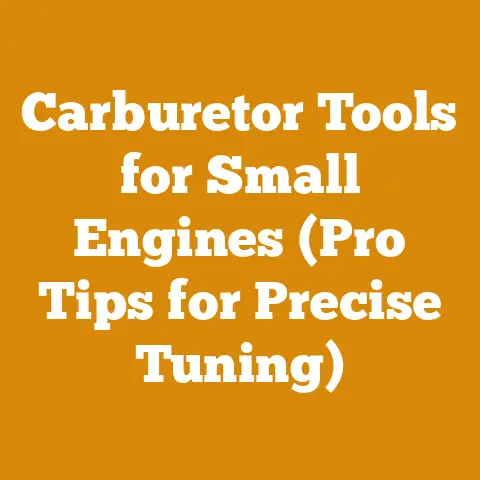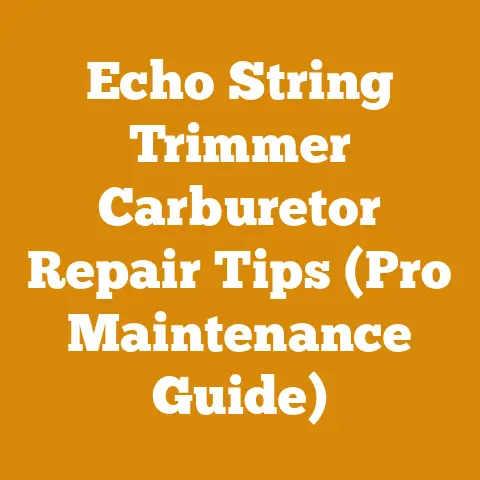525LS String Trimmer Review (Pro Tips for Woodland Clearing)
The Husqvarna 525LS string trimmer.
It’s not just a tool; it’s a symphony of power and precision, a brushstroke of order against the chaotic canvas of overgrown woodlands.
I remember the first time I laid eyes on one – the sleek orange body, the promise of untamed vegetation bending to its will.
It’s an aesthetic marvel, yes, but the real beauty lies in its performance, especially when taming the wild fringes of our wooded properties.
Husqvarna 525LS String Trimmer Review: Pro Tips for Woodland Clearing
The Husqvarna 525LS isn’t your average weekend warrior’s trimmer.
This is a machine built for serious work, for reclaiming territory from the relentless advance of nature.
But even the best tool is only as good as the hand that wields it.
In this review, I’ll not only delve into the specs and performance of the 525LS, but I’ll also share pro tips gleaned from years of battling brambles, clearing underbrush, and turning unruly woodlands into tidy havens.
Most importantly, I’ll break down the real costs associated with using this machine for woodland clearing, helping you budget wisely and avoid those unexpected expenses that can quickly turn a productive project into a financial burden.
Unboxing the Beast: First Impressions and Key Features
The 525LS immediately strikes you as a professional-grade tool.
It’s lightweight, which is crucial for extended use, but it doesn’t feel flimsy.
The engine, a 25.4cc X-Torq, hums with a quiet authority, promising ample power without excessive fuel consumption.
Here’s a quick rundown of the key features:
- X-Torq Engine: Husqvarna’s patented engine technology reduces emissions by up to 75% and increases fuel efficiency by up to 20%.
This translates to less environmental impact and more work per tank. - Smart Start: This feature reduces the resistance in the starter cord by up to 40%, making it incredibly easy to start, even on cold mornings.
Trust me, after a long winter, this is a godsend. - Tap ‘n Go Trimmer Head: This allows you to easily advance the trimmer line by tapping the head on the ground.
It’s a simple but incredibly useful feature that saves time and frustration. - Intuitive Controls: The choke and purge are easily accessible and clearly marked, making operation straightforward, even for those new to gas-powered trimmers.
- Comfortable Harness: The included harness distributes the weight of the trimmer evenly, reducing strain on your back and shoulders.
This is essential for long days of woodland clearing.
Power and Performance: Taming the Wilderness
The 525LS is a true workhorse.
I’ve used it to clear everything from delicate grasses to thick brush and even small saplings.
The X-Torq engine provides ample power, allowing you to slice through vegetation with ease.
The key to effective woodland clearing with the 525LS is understanding its limitations and choosing the right cutting attachment.
- Line Selection: For general trimming and grass cutting, standard .095″ trimmer line works well.
However, for thicker brush and weeds, I recommend using a heavier-duty line, such as .105″ or even .130″.
A square or star-shaped line will provide more aggressive cutting action. - Blade Attachments: For tackling small saplings and dense brush, consider using a brush blade attachment.
Husqvarna offers a variety of blade options, including metal blades and plastic blades.
Always wear appropriate safety gear, including eye protection and leg protection, when using a blade attachment.
I once had a small rock flung up and hit my safety glasses – a stark reminder of the importance of protection. - Technique: Don’t try to cut too much at once.
Work in small sections, overlapping your cuts to ensure a clean and even finish.
For thicker brush, use a sweeping motion, gradually cutting through the vegetation.
Pro Tips for Woodland Clearing with the 525LS
Over the years, I’ve learned a few tricks that can make woodland clearing with the 525LS more efficient and less strenuous.
- Sharpen Your Blades: If you’re using a brush blade attachment, keep it sharp.
A dull blade will require more effort and can be dangerous.
Use a file or grinder to sharpen the blade regularly. - Use a Shoulder Harness: The included shoulder harness is essential for long days of clearing.
Adjust the harness so that the trimmer hangs comfortably at your side. - Take Breaks: Don’t try to work for hours without stopping.
Take frequent breaks to rest and rehydrate.
Woodland clearing is physically demanding work, and it’s important to pace yourself. - Clear Debris: As you clear vegetation, remove the debris to prevent it from getting tangled in the trimmer head.
This will also make it easier to see what you’re doing. - Work in Sections: Divide your woodland into sections and tackle one section at a time.
This will make the task seem less daunting and will help you stay organized. - Consider the Time of Year: The best time to clear woodlands is during the dormant season, when vegetation is less active.
This will make the job easier and will minimize the impact on wildlife. - Be Aware of Hazards: Before you start clearing, survey the area for potential hazards, such as rocks, roots, and hidden objects.
Wear appropriate safety gear to protect yourself from these hazards. - Protect Young Trees: Be careful not to damage young trees or shrubs that you want to keep.
Use the trimmer to clear vegetation around them, but avoid cutting into the bark. - Dispose of Debris Properly: Dispose of the cleared vegetation properly.
You can compost it, burn it (where permitted), or haul it away to a landfill. - Maintain Your Trimmer: Regular maintenance is essential for keeping your 525LS running smoothly.
Clean the air filter regularly, change the spark plug annually, and lubricate the trimmer head.
The Real Cost of Woodland Clearing: A Deep Dive
Okay, let’s get down to brass tacks.
The Husqvarna 525LS is a fantastic tool, but it’s not free.
And the cost of the trimmer itself is just the tip of the iceberg.
To accurately budget for woodland clearing, you need to consider all the associated expenses.
I’ve seen too many projects stall because of underestimated costs, and I don’t want that to happen to you.
1. Initial Investment: The Trimmer and Accessories
- Husqvarna 525LS: The price of the 525LS typically ranges from $350 to $450, depending on the retailer and any ongoing promotions.
I recommend shopping around to find the best deal. - Brush Blade Attachment: A good quality brush blade attachment will cost between $30 and $50.
- Heavy-Duty Trimmer Line: A spool of heavy-duty trimmer line (e.g., .105″ or .130″) will cost around $20 to $30.
- Fuel Can: A good quality fuel can is essential for storing and transporting fuel.
Expect to pay around $20 to $30. - Mixing Container: For mixing two-stroke oil and gasoline, a dedicated mixing container with clear measurement markings is invaluable.
These typically cost between $10 and $15. - Safety Gear: Safety gear is non-negotiable.
This includes:- Eye Protection: Safety glasses or a face shield ($10 – $30)
- Hearing Protection: Earplugs or earmuffs ($10 – $20)
- Leg Protection: Chaps or heavy-duty pants ($30 – $100)
- Gloves: Work gloves ($10 – $20)
- Steel-Toed Boots: Essential for foot protection ($50 – $150)
Estimated Initial Investment: $520 – $835
2. Fuel and Oil Costs: The Constant Drain
The 525LS is a two-stroke engine, which means it requires a mixture of gasoline and two-stroke oil.
Fuel consumption will vary depending on the type of vegetation you’re clearing and how hard you’re pushing the trimmer.
- Gasoline: Let’s assume you’re paying $4 per gallon for gasoline.
- Two-Stroke Oil: A good quality two-stroke oil will cost around $20 per gallon.
- Mixing Ratio: The 525LS requires a 50:1 mixing ratio (50 parts gasoline to 1 part oil).
Calculating Fuel and Oil Costs:
- Oil per Gallon of Gas: For a 50:1 ratio, you’ll need 2.6 ounces of oil per gallon of gasoline (128 ounces / 50 = 2.56 ounces).
- Cost of Oil per Gallon of Gas: If oil costs $20 per gallon, then 2.6 ounces will cost approximately $0.41 (20 / 128 * 2.6 = $0.406).
- Total Cost per Gallon of Mixed Fuel: $4 (gas) + $0.41 (oil) = $4.41 per gallon.
Estimating Fuel Consumption:
- The 525LS has a fuel tank capacity of approximately 0.45 liters (0.12 gallons).
- Let’s assume you can run the trimmer for 1 hour on a full tank.
This is a conservative estimate, as fuel efficiency can vary.
Fuel Cost per Hour:
- $4.41 per gallon / 0.12 gallons per hour = $0.53 per hour.
Important Note: These are just estimates.
Your actual fuel consumption will vary depending on your specific circumstances.
I recommend keeping track of your fuel usage to get a more accurate picture of your costs.
3. Maintenance Costs: The Long-Term Investment
Regular maintenance is essential for keeping your 525LS running smoothly and extending its lifespan.
Neglecting maintenance can lead to costly repairs down the road.
- Air Filter: Clean the air filter regularly (every 25 hours of use) or replace it as needed.
Air filters typically cost between $5 and $10. - Spark Plug: Replace the spark plug annually. Spark plugs cost around $5 to $10.
- Fuel Filter: Replace the fuel filter annually. Fuel filters cost around $5 to $10.
- Grease: Lubricate the trimmer head regularly with grease.
A tube of grease will cost around $5 to $10. - Trimmer Line: Replenishing trimmer line is an ongoing expense.
A spool of trimmer line will cost around $20 to $30. - Blade Sharpening: If you’re using a brush blade attachment, you’ll need to sharpen it regularly.
You can do this yourself with a file or grinder, or you can take it to a professional.
Professional sharpening typically costs between $10 and $20 per blade. - Repairs: Even with regular maintenance, repairs are inevitable.
The cost of repairs will vary depending on the nature of the problem.
Estimating Annual Maintenance Costs:
- Air Filter: $7.50 (average cost)
- Spark Plug: $7.50 (average cost)
- Fuel Filter: $7.50 (average cost)
- Grease: $7.50 (average cost)
- Trimmer Line: $25 (average cost, assuming you use one spool per year)
- Blade Sharpening: $20 (assuming you sharpen the blade twice per year)
- Repairs: This is the most unpredictable cost.
Let’s estimate $50 per year for potential repairs.
Total Estimated Annual Maintenance Costs: $125
4. Labor Costs: The Value of Your Time
If you’re doing the woodland clearing yourself, you need to consider the value of your time.
How much is your time worth per hour?
This is a subjective question, but it’s important to consider.
Even if you’re not paying yourself directly, your time has value.
- Opportunity Cost: What else could you be doing with your time?
Could you be working a paid job, spending time with family, or pursuing a hobby? - Physical Labor: Woodland clearing is physically demanding work. It can be tiring and time-consuming.
Estimating Labor Costs:
- Let’s assume your time is worth $20 per hour.
- If you spend 10 hours per week clearing woodlands, your labor cost is $200 per week.
5. Disposal Costs: The Unseen Expense
Clearing woodlands generates a lot of debris.
You need to dispose of this debris properly.
- Composting: If you have a compost pile, you can compost some of the debris.
- Burning: In some areas, you may be able to burn the debris.
However, you need to check local regulations and obtain any necessary permits. - Hauling: If you can’t compost or burn the debris, you’ll need to haul it away to a landfill.
This can be expensive, especially if you have a lot of debris.
Estimating Disposal Costs:
- Landfill Fees: Landfill fees vary depending on the location and the type of debris.
Let’s assume you’re paying $50 per ton for landfill disposal. - Transportation Costs: You’ll also need to factor in the cost of transporting the debris to the landfill.
This will depend on the distance and the type of vehicle you’re using.
Example Scenario:
Let’s say you’re clearing a 1-acre plot of woodland.
You estimate that you’ll generate 5 tons of debris.
- Landfill Fees: 5 tons * $50 per ton = $250
- Transportation Costs: Let’s assume you can haul 1 ton of debris per trip, and each trip costs $20.
You’ll need 5 trips, so your transportation costs will be $100. - Total Disposal Costs: $250 + $100 = $350
6. Permit Costs: The Bureaucratic Hurdle
In some areas, you may need to obtain permits before you can clear woodlands.
Permit requirements vary depending on the location and the type of clearing you’re doing.
- Local Regulations: Check with your local government to determine what permits are required.
- Environmental Impact: Some clearing projects may require an environmental impact assessment.
Estimating Permit Costs:
- Permit costs can range from a few dollars to hundreds of dollars, depending on the complexity of the project.
7. Depreciation: The Silent Killer
The Husqvarna 525LS is a durable tool, but it will eventually wear out.
You need to factor in depreciation when calculating the true cost of woodland clearing.
- Lifespan: Let’s assume the 525LS has a lifespan of 5 years.
- Depreciation Rate: The annual depreciation rate is 20% (100% / 5 years).
Calculating Annual Depreciation:
- Original Cost: $400 (average cost of the 525LS)
- Annual Depreciation: $400 * 20% = $80
Putting It All Together: A Cost Summary
Let’s summarize all the costs we’ve discussed.
This is based on the assumptions we made earlier.
Your actual costs may vary.
One-Time Costs:
- Husqvarna 525LS: $400
- Brush Blade Attachment: $40
- Heavy-Duty Trimmer Line: $25
- Fuel Can: $25
- Mixing Container: $12.50
- Safety Gear: $100
Total One-Time Costs: $602.50
Annual Recurring Costs:
- Fuel and Oil: $26.50 (assuming 50 hours of use per year)
- Maintenance: $125
- Labor: $10,400 (assuming 10 hours per week at $20 per hour)
- Disposal: $350 (assuming 5 tons of debris per year)
- Permits: $50 (estimated)
- Depreciation: $80
Total Annual Recurring Costs: $11,031.50
Total Cost Over 5 Years:
- One-Time Costs: $602.50
- Annual Recurring Costs (5 years): $11,031.50 * 5 = $55,157.50
- Total Cost: $602.50 + $55,157.50 = $55,760
Cost Per Hour of Use:
- Total Hours Over 5 Years: 50 hours per year * 5 years = 250 hours
- Cost Per Hour: $55,760 / 250 hours = $223.04 per hour
As you can see, the cost of woodland clearing can be significant.
The labor cost is the biggest factor, followed by disposal costs and the initial investment in the trimmer and accessories.
Cost Optimization Strategies: Saving Money Without Sacrificing Quality
Now that we’ve broken down all the costs, let’s discuss some strategies for optimizing your budget and saving money without sacrificing quality.
- Shop Around for the Best Deals: Don’t just buy the first 525LS you see.
Shop around and compare prices from different retailers.
Look for sales and promotions. - Buy Used Equipment: Consider buying a used 525LS or other equipment.
You can often find good deals on used equipment that is still in good working condition.
However, be sure to inspect the equipment carefully before you buy it. - Rent Equipment: If you only need the 525LS for a short period of time, consider renting it instead of buying it.
Rental rates vary depending on the location and the type of equipment.
In the US, you can expect to pay around $50-$75 per day for a string trimmer rental from companies like Home Depot or Sunbelt Rentals.
I’ve often found that renting for a weekend project is far more economical than purchasing outright. - Maintain Your Equipment Properly: Regular maintenance is essential for extending the lifespan of your equipment and preventing costly repairs.
Follow the manufacturer’s recommendations for maintenance. - Do the Work Yourself: If you have the time and the ability, do the woodland clearing yourself.
This will save you a significant amount of money on labor costs.
However, be realistic about your abilities and don’t take on more than you can handle. - Recycle Debris: Instead of hauling the debris to a landfill, try to recycle it.
You can compost some of the debris, or you can use it as mulch. - Negotiate Prices: Don’t be afraid to negotiate prices with suppliers and contractors.
You may be surprised at how much you can save. - Plan Ahead: Plan your woodland clearing project carefully.
This will help you avoid unexpected costs and delays. - Prioritize Tasks: Focus on the most important tasks first.
This will help you make the most of your time and resources. - Learn New Skills: Learning new skills can help you save money on labor costs.
For example, if you learn how to sharpen your own brush blades, you can save money on sharpening fees.
The Importance of Accurate Record Keeping
One of the most important things you can do to manage your woodland clearing budget is to keep accurate records.
Track all your expenses, including the cost of the 525LS, fuel, oil, maintenance, labor, disposal, permits, and depreciation.
This will help you see where your money is going and identify areas where you can save money.
- Spreadsheets: Use a spreadsheet to track your expenses.
- Accounting Software: Consider using accounting software to manage your finances.
- Receipts: Keep all your receipts for tax purposes.
Case Study: A Real-World Example
Let’s look at a real-world example of how to budget for woodland clearing.
I recently helped a friend clear a 2-acre plot of woodland on his property.
Here’s how we approached the project:
- Assessment: We started by assessing the area to be cleared.
We identified the types of vegetation that needed to be removed, the terrain, and any potential hazards. - Planning: We developed a detailed plan for the project.
We divided the area into sections and determined the order in which we would clear them. - Budgeting: We created a budget for the project, taking into account all the costs we’ve discussed.
- Equipment: We used a Husqvarna 525LS, a brush blade attachment, and various hand tools.
- Labor: We did most of the work ourselves, but we hired a contractor to haul away the debris.
- Disposal: We composted some of the debris and hauled the rest away to a landfill.
- Record Keeping: We kept accurate records of all our expenses.
Here’s a summary of the costs:
- Equipment (existing): $0 (My friend already owned a 525LS and other equipment)
- Brush Blade Attachment: $40
- Heavy-Duty Trimmer Line: $25
- Fuel and Oil: $50
- Contractor (debris removal): $500
- Landfill Fees: $200
- Permits: $0 (No permits were required)
Total Cost: $815
The project took us about 40 hours to complete.
If we had hired a contractor to do the entire job, it would have cost us significantly more.
The Bottom Line: Knowledge is Power
The Husqvarna 525LS is a powerful and versatile tool that can make woodland clearing easier and more efficient.
However, it’s important to understand the true cost of using this machine and to budget accordingly.
By taking the time to plan your project, track your expenses, and implement cost optimization strategies, you can save money and achieve your woodland clearing goals.
Remember, “a penny saved is a penny earned.” By carefully managing your budget, you can turn your woodland clearing project into a rewarding and financially sound investment.
Now, go forth and tame the wilderness!
Future Considerations and Technological Advancements
As technology marches on, the landscape of woodland clearing is also evolving.
Here are a few future considerations and technological advancements to keep in mind:
- Battery-Powered Trimmers: Battery-powered trimmers are becoming increasingly popular.
They offer several advantages over gas-powered trimmers, including lower emissions, quieter operation, and easier maintenance.
However, they also have some limitations, such as shorter run times and less power.
The Husqvarna 525iL is a battery-powered alternative, but the initial cost and battery life need careful consideration. - Robotic Mowers: Robotic mowers are already being used in some residential settings.
In the future, we may see robotic mowers being used for woodland clearing.
These machines could be programmed to clear vegetation automatically, reducing the need for manual labor. - Drones: Drones can be used to survey woodlands and identify areas that need to be cleared.
They can also be used to monitor the progress of clearing projects. - GPS Technology: GPS technology can be used to map woodlands and track the location of clearing equipment.
This can help improve efficiency and prevent accidents. - Improved Safety Features: Manufacturers are constantly developing new safety features for woodland clearing equipment.
These features can help reduce the risk of accidents and injuries.
By staying informed about these future considerations and technological advancements, you can make more informed decisions about your woodland clearing projects.
Final Thoughts: A Global Perspective
Woodland clearing is a global activity, practiced in diverse environments and for various purposes.
From the boreal forests of Scandinavia to the tropical rainforests of South America, people around the world are managing woodlands for timber production, agriculture, and conservation.
The challenges and opportunities associated with woodland clearing vary depending on the region.
In some areas, deforestation is a major concern.
In other areas, sustainable forestry practices are being implemented to protect woodlands and ensure their long-term health.
No matter where you are in the world, it’s important to approach woodland clearing responsibly and sustainably.
By using the right tools, implementing best practices, and carefully managing your budget, you can clear woodlands in a way that benefits both people and the environment.
Remember, we are all stewards of the land, and it’s our responsibility to protect it for future generations.






